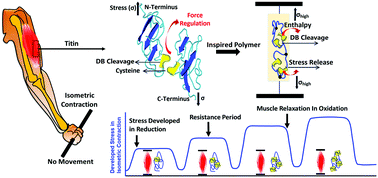A titin inspired stress-memory polymer acts as a muscle†
Abstract
Muscle materials have become extremely important for flexible robotics due to the advancement of materials, artificial intelligence and requests for widespread applications. Considerable effort has been focused on realizing muscle-like movements with isotonic contraction, but there have been few reports on artificial muscles meeting the vital requirement of isometric contraction, where the muscle does not shorten, but stress can be produced. We report here such a polymer, which can act as a muscle in isometric contraction. It mimics not only the generation of a reversible force but also a redox environment and the specific role of the disulfide bond (DB) in real muscles. As a covalent bond widely available in biosystems, particularly in the titin of muscles, DB provides a plentiful enthalpy contribution to proteins thermodynamically under redox conditions. We thus fabricated polyurethane with different DB content values and observed the existence of memory stress mimicking isometric contraction, reaching 47% of programmed stress. Accordingly, a muscle model is proposed where a protein DB with an enthalpy change is responsible for stress changes. It is believed that this reflects the smart behaviors of biological materials, including natural fibers, and can be applied as enthalpy-driven energy storage for artificial muscles. Meanwhile, it sheds lights on the functions of DBs in biological systems.



 Please wait while we load your content...
Please wait while we load your content...